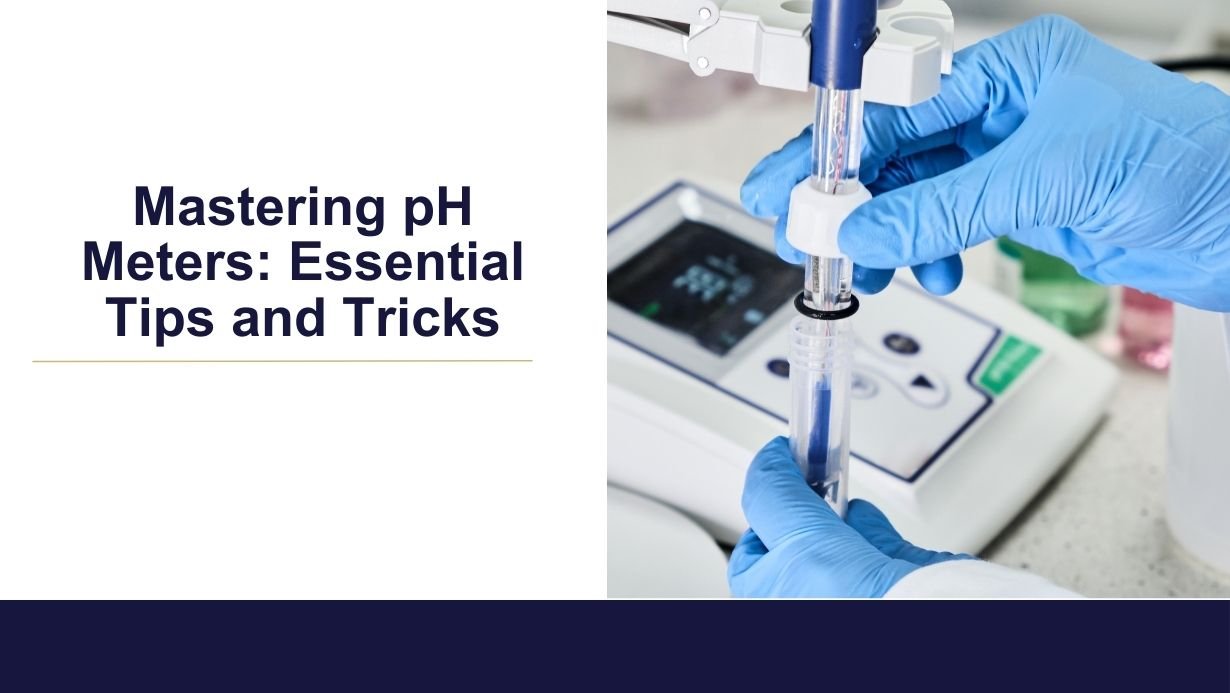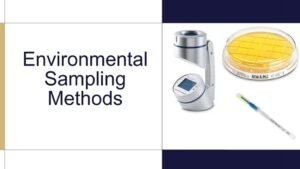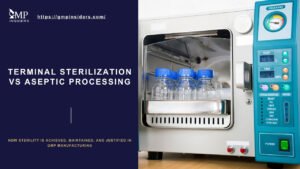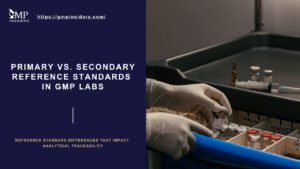In Quality Control (QC) laboratories, accurate pH measurements are crucial for ensuring product quality and consistency. pH meters are essential tools for this purpose, but to maintain their precision, regular calibration, proper handling, and meticulous maintenance are imperative. This article provides a comprehensive guide on these aspects to help you get the best performance from your pH meters.
What Is pH
pH is defined as the negative logarithm of the activity of hydrogen ions in a solution, typically expressed as the concentration of hydrogen ions [H+]. It ranges from 0 to 14, with 7 being neutral, values below 7 indicating acidity, and values above 7 indicating alkalinity.
It is determined using the formula pH = -log[H⁺], where [H⁺] represents the molar concentration of hydrogen ions. This logarithmic scale means that each whole number change on the pH scale corresponds to a tenfold change in hydrogen ion concentration.
How Does a pH Meter Work
The potentiometric determination of pH involves measuring the potential difference between two electrodes submerged in the test solution. One electrode is sensitive to hydrogen ions, while the other is a reference electrode, usually a silver-silver chloride electrode. Modern pH meters integrate these electrodes with a temperature sensor into a single component, ensuring accuracy and reliability.
Temperature Compensation for pH Measurements
Temperature significantly affects the pH measurement of a solution because the activity of hydrogen ions is temperature-dependent. Modern pH meters include automatic temperature compensation (ATC) to adjust readings based on the solution’s temperature.
Tip: For precise pH measurements, it’s essential to ensure that test samples are at the same temperature as the buffer solutions used for calibration. This practice helps to account for temperature variations and maintain consistency in quality control processes.
Why Do You Need to Calibrate a pH Meter
Over time, the performance of pH electrodes can degrade due to regular use, exposure to different chemical environments, and physical wear and tear. This degradation can lead to drifts in the readings, where the meter may consistently provide values that are slightly higher or lower than the actual pH of the solution. Regular calibration corrects for these drifts, ensuring that the pH meter maintains its accuracy over time. Calibration aligns the pH meter with known pH standards, ensuring accurate readings.
The choice of buffer standards for calibration is based on the expected pH range of the test solutions. It is crucial to select buffer solutions that bracket the expected pH values of your measurements. For accurate calibration, the expected pH value of the test solution should fall within the range defined by the reference buffer set.
Types of Calibration for pH Meters
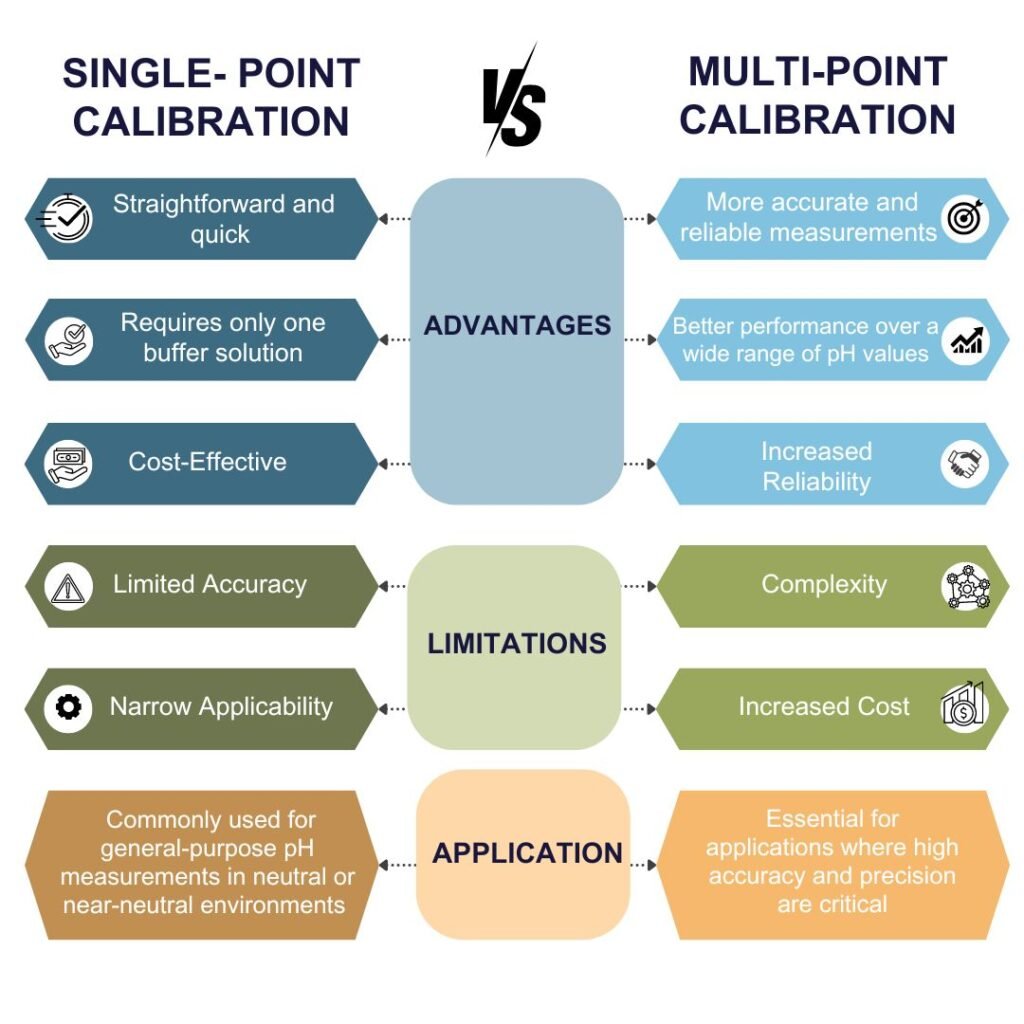
There are primarily two types of calibration methods used for pH meters: single-point calibration and multi-point calibration. Understanding these methods and their respective advantages and limitations is crucial for selecting the appropriate calibration technique based on the specific needs of the application.
Single-Point Calibration
Single-point calibration involves calibrating the pH meter using a single buffer solution. This method adjusts the meter to recognize the known pH value of the buffer solution, aligning the pH meter’s output with this single reference point.
Advantages:
- Simplicity: Single-point calibration is straightforward and quick, making it ideal for routine checks or when time is limited.
- Convenience: Requires only one buffer solution, reducing preparation and cleanup time.
- Cost-Effective: Fewer calibration solutions are needed, lowering the overall cost.
Limitations:
- Limited Accuracy: Since the calibration is based on a single reference point, the accuracy of the pH meter may decrease when measuring solutions with pH values far from the calibration point.
- Narrow Applicability: Best suited for applications where the expected pH range is close to the calibration point or where high precision is not critical.
Applications: Single-point calibration is often used for general-purpose pH measurements in environments where the expected pH values are neutral or near-neutral, such as in educational settings, preliminary testing, or field measurements where convenience and speed are prioritized over precision.
Multi-Point Calibration
Multi-point calibration involves using two or more buffer solutions with different pH values (e.g., pH 4.01, pH 7.00, and pH 10.01). This method adjusts the pH meter across a range of pH values, creating a calibration curve that aligns the meter’s output with multiple reference points.
When combining reference buffer standards for calibration, it is important to ensure that the difference between two buffer solutions is at least 2 pH units. This approach helps create a more accurate calibration curve, which enhances the reliability of the pH measurements across a broader range.
Advantages:
- Enhanced Accuracy: By calibrating the meter at multiple points, multi-point calibration provides more accurate and reliable measurements across a broader pH range.
- Comprehensive Calibration: Accounts for the nonlinear response of pH electrodes, ensuring better performance over a wide range of pH values.
- Increased Reliability: Identifies and corrects for potential errors or drifts at different pH levels, enhancing overall measurement reliability.
Limitations:
- Complexity: Multi-point calibration is more complex and time-consuming, requiring careful preparation and handling of multiple buffer solutions.
- Increased Cost: Requires more buffer solutions and potentially more frequent electrode maintenance.
Applications: Multi-point calibration is essential for applications where high accuracy and precision are critical, such as in QC laboratories, pharmaceutical manufacturing, environmental testing, and any other scientific research requiring reliable pH measurements across a wide range of values.
RELATED: GMP vs GLP – Top 10 differences
Calibration of the Temperature Sensor in pH Meters
Temperature plays a crucial role in the accuracy of pH measurements because the activity of hydrogen ions in a solution is temperature-dependent. Modern pH meters are equipped with temperature sensors to provide automatic temperature compensation (ATC), which adjusts the pH reading based on the temperature of the solution. For precise pH measurements, it is essential to ensure that the temperature sensor itself is accurately calibrated.
Calibration Frequency: How Often Should You Calibrate
Internal calibrations (within the lab) should be performed at least once a day using traceable/certified reference buffer standards. The selected buffer standards should bracket the expected pH range of the test solutions.
While internal calibrations are performed daily, external calibration by an authorized service provider is typically conducted annually. Each QC lab should define its calibration intervals based on its quality management system.
Criteria for Successful Calibration
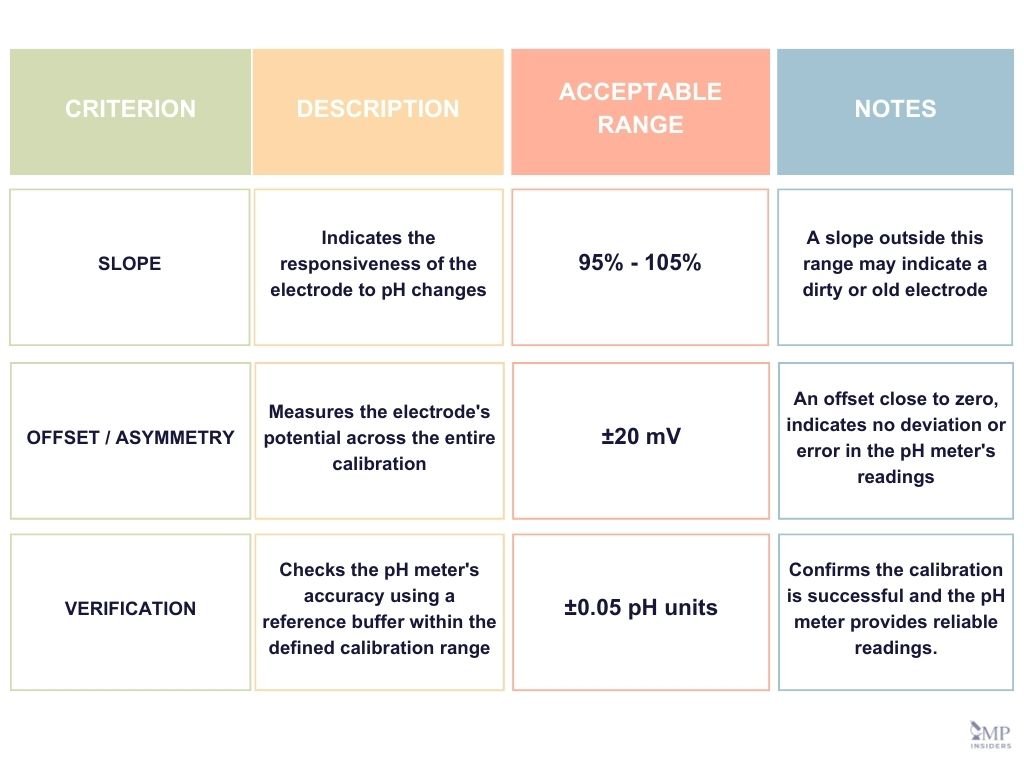
While manufacturers often provide specific criteria for their devices, general GMP regulatory guidelines aligned with Ph. Eur. 2.2.3. POTENTIOMETRIC DETERMINATION OF pH can be used to evaluate the success of the calibration process and the condition of the pH sensor. Here are the key criteria to consider:
Slope (95%-105%)
The slope value, which is derived from the calibration of the pH meter using at least two buffer solutions, should be within the range of 95% to 105%. This range indicates the responsiveness of the electrode to changes in pH. A slope value within this range means the electrode is functioning correctly. If the slope falls below 95%, it often indicates that the electrode is dirty or old. In such cases, thorough cleaning is advised, and if the issue persists, the electrode may need to be replaced.
Note: A strong indicator that the electrode requires replacement is when the slope value falls outside the broader range of 90% to 110%.
Offset / Asymmetry (±20 mV)
The offset value during calibration, also known as the asymmetry potential, should not exceed ±20 millivolts (mV). A value of 0 mV represents the electrode’s potential when immersed in a neutral pH buffer (pH 7.00). An offset within this range indicates that the electrode is balanced and functioning correctly. However, an offset value deviating between 20 mV and 30 mV usually indicates that the pH sensor is contaminated and needs to be cleaned. If the offset values remain outside this range even after cleaning, it may suggest that the pH sensor is old or damaged and needs replacement.
Verification of Calibration (±0.05 pH units)
After completing the calibration with the buffer solutions, verification should be conducted using a certified reference buffer that falls within the calibration range. The output reading of the pH meter should not deviate by more than ±0.05 pH units from the nominal pH value of the reference buffer. This verification step ensures that the calibration is accurate and that the pH meter provides reliable measurements.
Documenting the Calibration of the pH Meter
Documenting the calibration event of a pH meter is essential for ensuring traceability, compliance with GDocP (Good Documentation Practices), and ongoing accuracy in quality control processes. Proper documentation serves as a record of the calibration’s validity and can be crucial during audits or reviews.
What to Include in the Calibration Logbook
- Analyst Signature: The logbook should include the signature of the analyst who performed the calibration. This ensures accountability and verifies that a qualified individual conducted the calibration.
- Date and Time: Record the exact date and time when the calibration was performed. This helps in tracking the calibration frequency and ensures that calibrations are conducted at regular intervals.
- Reference Buffer Information: Document the details of the reference buffer solutions used during calibration. This should include the pH values of the buffers and their expiration dates to ensure that only valid and accurate buffers are used.
- Criteria Results: Record the results of the calibration criteria, including the slope, offset, and verification values. Ensure these results are within the acceptable ranges (slope: 95%-105%, offset: ±30 mV, verification: ±0.05 pH units). If any of the criteria are not met, note any corrective actions taken, such as cleaning the electrode or repeating the calibration.
pH Meter Calibration Steps

1. Gather Materials:
- pH meter with an integrated or separate temperature sensor.
- Certified reference buffer solutions (e.g., pH 4.01, pH 7.00, and pH 10.01).
- Distilled or deionized water for rinsing the pH sensor.
- Clean, lint-free tissues or paper towels for blotting the pH sensor.
- Containers for the buffer solutions.
- Calibration logbook or digital record-keeping tool.
2. Inspect the Equipment:
- Ensure the pH meter and its sensor are clean and in good working condition.
- Check the expiration dates of the buffer solutions to ensure they are not expired.
3. Prepare the Buffers:
- Pour the buffer solutions into clean containers. Ensure each container is labeled with the corresponding pH value to avoid mix-ups.
- Allow buffer solutions to reach room temperature if they are stored at different temperatures.
4. Turn on the pH Meter:
- Power on the pH meter and allow it to stabilize. This usually takes a few minutes.
5. Rinse the Electrode:
- Rinse the pH electrode with distilled or deionized water to remove any contaminants from previous measurements.
- Blot the electrode gently with a lint-free tissue to remove excess water without damaging the electrode surface.
6. Immerse the First Buffer Solution:
- Immerse the pH sensor into the buffer solution. Ensure the electrode is fully submerged and not touching the sides or bottom of the container.
- Stir gently to ensure the solution is homogeneous and to remove any air bubbles.
7. Wait for Stabilization:
- Allow the pH meter reading to stabilize. This may take a few seconds to a few minutes, depending on the pH meter and electrode.
- Most pH meters automatically recognize the buffer and adjust accordingly. Verify the adjustment according to the manufacturer’s instructions.
8. Rinse and Blot the Electode:
- Rinse the electrode with distilled water and blot it dry with a lint-free tissue.
9. Repeat steps 6 to 9 for Multi-Point Calibration:
- Immerse the electrode in the second buffer solution. Choose a buffer that is closest to the expected pH range of your samples if doing a two-point calibration.
- Repeat steps 6 to 9 for all reference buffer solutions contained in the buffer set for multi-point calibration.
10. Verify Calibration
- After calibrating with the final buffer solution, rinse the electrode and immerse it into a reference buffer solution (within the calibration range) to verify the calibration.
- The reading should be within ±0.05 pH units of the known buffer value. If not, clean or replace the electrode and repeat the calibration procedure.
- Store the electrode in a storage solution (usually 3M KCl) or as recommended by the manufacturer.
11. Document Calibration:
- Document the calibration details in a logbook or digital record, including the date, time, buffer solutions used, electrode condition, and any adjustments made.
Types of Buffer Solutions Used for Calibration of pH Meters
Buffer solutions are essential for the accurate calibration of pH meters, as they provide known pH values against which the meter can be adjusted. There are two primary types of buffer solutions used for calibration: technical buffers and certified buffers.
Technical Buffers
Technical buffer solutions are prepared solutions that are traceable to certified reference materials. These buffers are often used for routine calibration and general-purpose applications where high precision is not critically required. Technical buffers provide reliable pH values and are suitable for many laboratory environments. However, they are not individually certified and may have slightly broader tolerances compared to certified buffers. Despite this, they are a cost-effective option for daily calibrations and can still ensure adequate accuracy for many types of measurements.
Certified Buffers
Certified buffer solutions, such as those conforming to standards like DIN (Deutsches Institut für Normung) or NIST (National Institute of Standards and Technology), offer a higher level of accuracy and traceability. These buffers are manufactured under stringent quality control processes and come with documentation certifying their pH value at specific temperatures. Certified buffers are essential for applications requiring the highest precision and regulatory compliance, such as in pharmaceutical, biomedical, and environmental testing. The certification provides assurance that the buffer values are accurate and consistent, thereby enhancing the reliability of the pH meter calibration.
Using a combination of technical and certified buffers allows laboratories to balance cost and precision, ensuring routine calibrations are economical while high-precision requirements are met with certified buffers. This approach helps maintain the integrity of pH measurements across various applications and regulatory environments.
Proper Storage and Handling of Buffer Solutions
Buffer solutions should be stored in tightly sealed containers to prevent contamination and evaporation. They should be kept at a stable, room temperature and away from direct sunlight or extreme temperatures, which can alter their pH values. It’s also important to avoid cross-contamination by using clean, separate containers and utensils for each buffer solution during calibration. Regularly check the expiration dates and discard any expired or contaminated buffers to ensure the integrity of the calibration process.
Proper Handling and Maintenance of pH Meters
The best practices for handling and maintenance of pH meters are always based on following the manufacturer’s instructions for setup and use. If not specified in an analytical procedure or monograph, test samples should be measured at the same temperature at which the calibration was performed, typically between 20°C and 25°C, with an allowable deviation of ±2.5°C. The pH sensor should be stored according to the manufacturer’s guidelines, usually submerged in an electrolyte solution like 3M KCl to maintain its hydration and functionality.
Before each measurement, visually inspect the pH sensor for any abnormalities, such as the presence of air bubbles, which can impair its functionality. If bubbles are present, gently shake and rotate the sensor to remove them. For pH sensors that require electrolyte filling, check the liquid level before each use and refill with the manufacturer’s recommended solution if the level is low. During measurements, ensure the opening orifice remains open to allow proper functioning, and close it after the measurement is complete.
If the pH meter’s readings are unstable or take too long to stabilize, and the slope and offset values show significant deviations, it is advisable to clean the pH sensor thoroughly. Persistent issues after cleaning may indicate that the pH sensor is old or damaged and needs to be replaced.
After each use, clean the pH sensor according to the manufacturer’s instructions to remove any residues and ensure longevity.
General Cleaning Protocols for pH Meters
- Regular Cleaning: Submerge the electrode in warm water with a non-aggressive detergent for 5 minutes, rinse with distilled water, and store in an electrolyte solution.
- Salt Residues: Clean by submerging in 0.1M HCl for 5 minutes, then in 0.1M NaOH for another 5 minutes. Rinse with distilled water and store in an electrolyte solution.
- Oil/Grease Residues: Clean with warm water and non-aggressive detergent or use methanol or ethanol (for glass electrodes only). Rinse with distilled water and store in an electrolyte solution.
Replacement of the pH Sensor
Replacing the pH sensor is necessary when it no longer provides accurate and stable readings despite regular calibration and cleaning. Indicators that a pH sensor needs replacement include significant deviations in slope and offset values during calibration, persistent instability in readings, and slow response times.
Additionally, physical signs such as visible damage, cracks, or an inability to maintain electrolyte levels in refillable electrodes signal the need for replacement. Regularly monitoring these factors ensures timely replacement of the pH sensor, maintaining the accuracy and reliability of pH measurements.
Common Handling Mistakes to Avoid
- Not rinsing the electrode between measurements
- Storing the electrode dry
- Using contaminated buffer solutions
FAQ
Can I Use Deionized Water as a Buffer Solution for Calibration?
No, deionized water should not be used as a buffer solution for calibration because it does not have a stable pH and lacks the necessary ionic strength. Always use certified reference buffer solutions specifically designed for pH meter calibration.
How Should I Store My pH Electrode When It Is Not in Use?
Store the pH electrode in a storage solution, typically 3M KCl or a solution recommended by the manufacturer. Never store the electrode dry, as this can damage the sensitive glass membrane and lead to inaccurate readings.
Why Is My pH Meter Taking a Long Time to Stabilize After Immersion in a Sample?
A long stabilization time can be due to a clogged junction, an old or damaged electrode, or temperature differences between the sample and electrode. Try cleaning the electrode and ensuring that the sample and electrode are at the same temperature. If the problem persists, the electrode may need to be replaced.
Can I Calibrate My pH Meter With Buffers That Are Past Their Expiration Date?
No, using expired buffer solutions can lead to inaccurate calibration and unreliable pH measurements. Always use fresh, unexpired buffer solutions for calibration to ensure the accuracy and reliability of your pH meter.
How Do I Handle pH Measurements for Viscous or Solid Samples?
For viscous or solid samples, use a specialized electrode designed for such applications. These electrodes often have a flat surface or open junction to prevent clogging and ensure accurate measurements. Follow the manufacturer’s instructions for the best results.
How Can I Ensure My pH Measurements Are Consistent Across Multiple Instruments?
To ensure consistency across multiple pH meters, calibrate all instruments using the same certified reference buffer solutions and follow the same calibration procedures. Regularly compare measurements between instruments to identify any discrepancies and address potential issues.
RELATED: Calibration of Analytical Balances and Performance Checks
Conclusion
Getting the most out of your pH meters in QC labs is all about paying attention to the details—regular calibration, proper handling, and thorough maintenance. By using the right buffer solutions and keeping your electrodes clean and well-cared for, you ensure your pH measurements are always reliable. This isn’t just about following rules; it’s about making sure your lab’s results are accurate and consistent and your products meet the highest standards. In the end, a little extra effort in maintaining your pH meters goes a long way in achieving trustworthy results in your lab.

